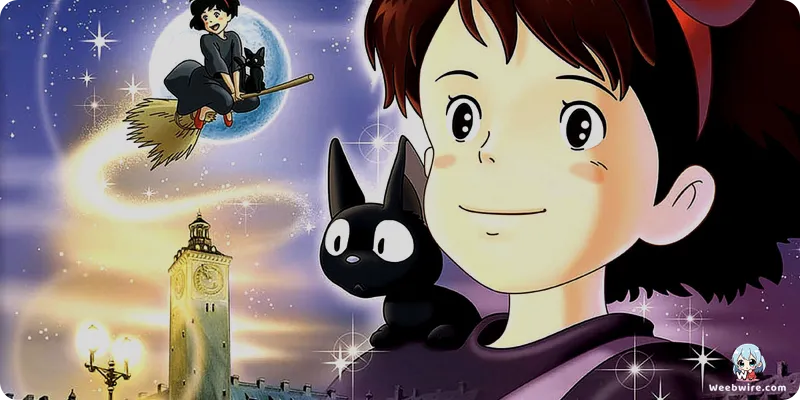Kiki's Delivery Service: Unveiling the Masterpiece's Hidden Depths and Enduring Impact

Often hailed as a timeless masterpiece, Hayao Miyazaki's 1989 animated film, Kiki's Delivery Service, transcends its enchanting facade to deliver a profound exploration of independence, self-doubt, and the often-turbulent journey into adulthood. While millions worldwide cherish Kiki's whimsical adventures as a young witch establishing her delivery service, the film is rich with meticulously crafted details and subtle narrative layers that amplify its enduring impact. Far beneath its charming surface lies a treasure trove of fascinating insights and hidden gems, many of which remain undiscovered even by long-time admirers.
A Narrative Reimagined: Divergence from the Novel
A crucial, yet frequently overlooked, aspect of the film is its significant divergence from Eiko Kadono's 1985 novel, the source material. While drawing inspiration from Kadono's work, Miyazaki deliberately reshaped the narrative and tone, transforming the episodic and lighter adventures of the book into a deeply resonant cinematic experience. Miyazaki imbued the story with a profound emotional depth, exploring themes of solitude, artistic struggle, and the inherent anxieties of maturation. Notably, he introduced entirely new characters and subplots, including Tombo's burgeoning passion for flight and Ursula's pivotal role as a supportive mentor, enriching Kiki's personal odyssey and amplifying the film's universal appeal to young individuals navigating their own uncertainties.
Koriko: A City Woven from European Dreams
The breathtakingly picturesque city of Koriko, Kiki's new home, stands as a testament to Miyazaki's meticulous artistry. To craft this vibrant urban landscape, the animation team undertook extensive research expeditions across Europe. Koriko is not a singular location but rather an exquisite composite, seamlessly blending architectural and atmospheric elements from diverse European cities, most prominently Stockholm, Sweden, alongside subtle influences from Lisbon, Paris, and even San Francisco. This painstaking attention to detail, evident in the city's intricate architecture, bustling streetscapes, and the nuanced depiction of daily life, profoundly contributes to the film's immersive quality, rendering Koriko a living, breathing entity that feels both familiar and wonderfully dreamlike.
Jiji's Silence: A Symbol of Maturation
Among the film's most discussed subtle nuances is the poignant evolution of Jiji, Kiki's sarcastic yet loyal black cat. In the original Japanese version, following Kiki's rediscovery of her flying abilities, Jiji ceases to communicate with her in human language, reverting solely to meows. This intentional artistic decision by Miyazaki powerfully symbolizes Kiki's burgeoning maturity and increasing self-reliance. As she grows, her need for Jiji as a constant, anthropomorphic confidante diminishes, signifying her newfound independence and a deeper integration into the human world. While the widely distributed Disney English dub notably diverges by allowing Jiji to speak again, Miyazaki's original vision underscores a critical facet of Kiki's coming-of-age: the subtle, sometimes bittersweet, fading of childhood comforts as one embraces adulthood.

The Artist's Struggle: Kiki's Creative Block
The film also subtly, yet profoundly, explores the universal struggle of 'artist's block' or creative burnout. Kiki herself grapples with a period where her magical abilities, particularly flight and her connection to Jiji, inexplicably wane. This is more than a mere physical setback; it serves as a powerful metaphor for creative stagnation, a challenge many artists and young adults confront when passion falters or purpose seems elusive. Ursula, the kindred spirit and painter Kiki encounters, openly shares her own battles with creative impasses, offering Kiki invaluable wisdom. Ursula's simple yet profound advice to continue creating even when inspiration is absent delivers a timeless message about the importance of perseverance and finding joy in the creative process itself, rather than solely in the outcome.
An Internal Journey: The Absence of an Antagonist
Distinct within the Studio Ghibli canon, Kiki's Delivery Service remarkably opts for the absence of a conventional antagonist. Unlike numerous fantasy narratives driven by external villains, Kiki's deepest conflicts are profoundly internal. Her struggles emanate from feelings of loneliness, pervasive self-doubt, and the immense pressure of forging her identity and purpose in an unfamiliar city. This deliberate focus on internal strife renders the film exceptionally relatable, mirroring the very real emotional hurdles young people encounter as they navigate the path to independence. Miyazaki meticulously designed a narrative where the protagonist's most formidable adversary is herself, powerfully underscoring that genuine growth often arises from confronting personal insecurities rather than external threats.
Ultimately, the enduring legacy of Kiki's Delivery Service, with its subtle yet profound messages of self-discovery and resilience, continues to enchant audiences across generations. Far more than a charming tale of a young witch and her feline companion, it stands as a deeply empathetic and universal portrayal of the journey into adulthood, replete with moments of quiet introspection and resonant emotional truth. The film's breathtaking hand-drawn animation, Joe Hisaishi's evocative musical score, and its timeless thematic core converge to create a cinematic experience that remains as vibrant and pertinent today as it was over three decades ago, a testament to its unparalleled artistry and heartfelt storytelling.
Credits
Kiki's Delivery Service
Author
Eiko Kadono
Cover Art
Hayao Miyazaki
Studio
Studio Ghibli
Publisher
Fukuinkan Shoten
Producers





